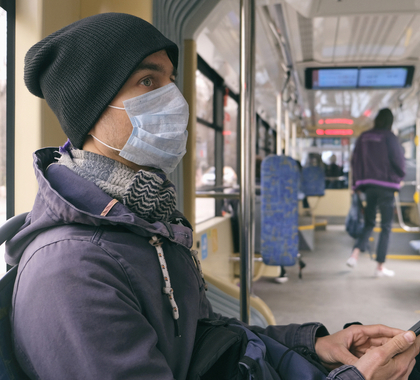Public transit systems play an important role in transporting people within our major cities. Buses, trains, streetcars, and ferry boats transport more than 27 million people each day in the United States. But U.S. public transit ridership has been declining for the last five years and the coronavirus pandemic is accelerating the decline.
Public transit ridership is measured by “unlinked passenger trips,” with a trip defined as whenever a person boards a transit vehicle, including transfers. Since 1970, the number of unlinked passenger trips grew about 37 percent to almost 10 billion trips in 2019. Transit miles grew more than 15 percent from 2000 to 2018, keeping pace with total U.S. vehicle miles traveled.
Public transit ridership consists of primarily bus (48 percent) and train (47 percent) transportation. The New York Metropolitan Area served 40 percent of U.S. public transit riders, with Chicago and Los Angeles distant second and third locations with just under 6 percent of U.S. ridership each.
Progressive leaders have long proposed the use of public transportation instead of private vehicles to save the environment. Senator Bernie Sanders stated, “For every $1 billion we invest in public transportation, we create 30,000 jobs, save thousands of dollars a year for each commuter, and dramatically cut greenhouse gas emissions.”
But U.S. residents don’t appear to agree. Since 2014, U.S. public transit ridership has been declining. From 2014 to 2019, unlinked passenger trips fell about 7.5 percent with transit mileage falling more than 9 percent. Public transit mileage dropped from about 2 percent to 1.7 percent of total vehicle miles traveled. Falling ridership is attributed to increased automobile ownership, lower gasoline prices, and flexible teleworking schedules.

This year, the corona virus pandemic plunged public transit ridership to its lowest level in more than a century. From January to April, unlinked passenger trips dropped 85 percent. Total vehicle miles also dropped, but by only about 42 percent.

The Centers for Disease Control issued guidelines calling for employers to support employee efforts to use “forms of transportation that minimize close contact with others,” including “driving or riding by car either alone or with household members.” If commuters have a choice, many appear to be avoiding public transportation.
Even before the pandemic, transit ridership was falling in key markets. Public ridership dropped 17 percent in the Los Angeles area from 2013 to 2018, despite billions spent to expand the L.A. public transit system.
This year, because of the virus, California ridership declined an additional 65 to 90 percent, depending upon metropolitan area. On June 29, the California Transit Association requested that governor Gavin Newsome provide $3.1 billion in funding relief to avoid permanent service reductions.
We’re now in the middle of a public transit crisis. Ridership in the New York Metropolitan Area, the nation’s largest public transit market, recovered from April lows, but by July still remained down more than 50 percent from 2019. The New York Metropolitan Transportation Authority projects losses from the pandemic of up to $8.5 billion. New York City may be looking at elimination of a large portion of subway lines without billions in Federal aid.
The jury is still out on whether the corona virus will cause permanent damage to U.S. public transit systems. But for now, it’s clear that many Americans value personal health and their love of cars more than the supposed environmental benefits of public transportation.





